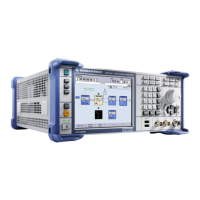Instrument Function
R&S
®
SMBV100A
161Operating Manual 1407.6062.32 ─ 08
"OFF"
The calibrated adjustment value of the internal reference frequency is
used. This value is determined at one of the R&S service shops during
calibration.
"ON"
A user-defined adjustment value is used. The value is entered under
"Adjustment DAC Value".
This allows the frequency to be impaired freely, for example to simulate
a frequency error.
The instrument is no longer in the calibrated state. However, the cali-
bration value is not changed and the instrument resumes the calibrated
state after switching the "Adjustment State" to Off.
SCPI command:
[:SOURce]:ROSCillator[:INTernal]:ADJust[:STATe] on page 692
Adjustment DAC Value
Enters a user-defined adjustment value for the internal reference frequency. This value
is not used unless "Adjustment Active On" is selected.
SCPI command:
[:SOURce]:ROSCillator[:INTernal]:ADJust:VALue on page 691
5.4.5 Local Oscillator - LO Coupling
The LO Coupling function allows a distribution of the local oscillator signal in way that
multiple RF signals can be driven by the same LO signal. This is mandatory for minimizing
the phase drift between these RF signals.
The LO Coupling function is available only for instruments equipped with the option R&S
SMBV-B90 (Phase Coherence).
The local oscillator signal is available at the LO OUT connector (rear of instrument).
In the external local oscillator mode, an external signal must be input at the LO IN con-
nector.
5.4.5.1 Phase Coherence
Phase coherence of two RF signals means that there is a defined and stable phase rela-
tionship between two (or more) RF carriers, i.e. there is a fixed delta phase ΔΦ between
the carriers. Strictly speaking, phase coherence is only defined for CW carriers with the
same frequency (or for CW carriers at frequencies that are multiples of each other).
RF Signal and Analog Modulations - RF Block

